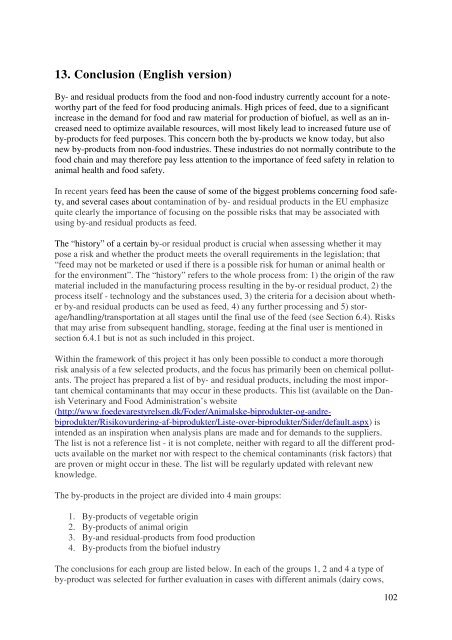Biprodukter fra fødevare - Fødevarestyrelsen
Biprodukter fra fødevare - Fødevarestyrelsen
Biprodukter fra fødevare - Fødevarestyrelsen
You also want an ePaper? Increase the reach of your titles
YUMPU automatically turns print PDFs into web optimized ePapers that Google loves.
13. Conclusion (English version)<br />
By- and residual products from the food and non-food industry currently account for a noteworthy<br />
part of the feed for food producing animals. High prices of feed, due to a significant<br />
increase in the demand for food and raw material for production of biofuel, as well as an increased<br />
need to optimize available resources, will most likely lead to increased future use of<br />
by-products for feed purposes. This concern both the by-products we know today, but also<br />
new by-products from non-food industries. These industries do not normally contribute to the<br />
food chain and may therefore pay less attention to the importance of feed safety in relation to<br />
animal health and food safety.<br />
In recent years feed has been the cause of some of the biggest problems concerning food safety,<br />
and several cases about contamination of by- and residual products in the EU emphasize<br />
quite clearly the importance of focusing on the possible risks that may be associated with<br />
using by-and residual products as feed.<br />
The “history” of a certain by-or residual product is crucial when assessing whether it may<br />
pose a risk and whether the product meets the overall requirements in the legislation; that<br />
“feed may not be marketed or used if there is a possible risk for human or animal health or<br />
for the environment”. The “history” refers to the whole process from: 1) the origin of the raw<br />
material included in the manufacturing process resulting in the by-or residual product, 2) the<br />
process itself - technology and the substances used, 3) the criteria for a decision about whether<br />
by-and residual products can be used as feed, 4) any further processing and 5) storage/handling/transportation<br />
at all stages until the final use of the feed (see Section 6.4). Risks<br />
that may arise from subsequent handling, storage, feeding at the final user is mentioned in<br />
section 6.4.1 but is not as such included in this project.<br />
Within the <strong>fra</strong>mework of this project it has only been possible to conduct a more thorough<br />
risk analysis of a few selected products, and the focus has primarily been on chemical pollutants.<br />
The project has prepared a list of by- and residual products, including the most important<br />
chemical contaminants that may occur in these products. This list (available on the Danish<br />
Veterinary and Food Administration’s website<br />
(http://www.foedevarestyrelsen.dk/Foder/Animalske-biprodukter-og-andrebiprodukter/Risikovurdering-af-biprodukter/Liste-over-biprodukter/Sider/default.aspx)<br />
is<br />
intended as an inspiration when analysis plans are made and for demands to the suppliers.<br />
The list is not a reference list - it is not complete, neither with regard to all the different products<br />
available on the market nor with respect to the chemical contaminants (risk factors) that<br />
are proven or might occur in these. The list will be regularly updated with relevant new<br />
knowledge.<br />
The by-products in the project are divided into 4 main groups:<br />
1. By-products of vegetable origin<br />
2. By-products of animal origin<br />
3. By-and residual-products from food production<br />
4. By-products from the biofuel industry<br />
The conclusions for each group are listed below. In each of the groups 1, 2 and 4 a type of<br />
by-product was selected for further evaluation in cases with different animals (dairy cows,<br />
102

















